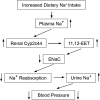The arachidonic acid monooxygenase: from biochemical curiosity to physiological/pathophysiological significance
- PMID: 30154230
- PMCID: PMC6210905
- DOI: 10.1194/jlr.R087882
The arachidonic acid monooxygenase: from biochemical curiosity to physiological/pathophysiological significance
Abstract
The initial studies of the metabolism of arachidonic acid (AA) by the cytochrome P450 (P450) hemeproteins sought to: a) elucidate the roles for these enzymes in the metabolism of endogenous pools of the FA, b) identify the P450 isoforms involved in AA epoxidation and ω/ω-1 hydroxylation, and c) explore the biological activities of their metabolites. These early investigations provided a foundation for subsequent efforts to establish the physiological relevance of the AA monooxygenase and its contributions to the pathophysiology of, for example, cancer, diabetes, hypertension, inflammation, nociception, and vascular disease. This retrospective analyzes the history of some of these efforts, with emphasis on genetic studies that identified roles for the murine Cyp4a and Cyp2c genes in renal and vascular physiology and the pathophysiology of hypertension and cancer. Wide-ranging investigations by laboratories worldwide, including the authors, have established a better appreciation of the enzymology, genetics, and physiologic roles for what is now known as the third branch of the AA cascade. Combined with the development of analytical and pharmacological tools, including robust synthetic agonists and antagonists of the major metabolites, we stand at the threshold of novel therapeutic approaches for the treatment of renal injury, pain, hypertension, and heart disease.
Keywords: PPAR; diseases; eicosanoids; endothelial cells; genetics; kidney.
Copyright © 2018 Capdevila and Falck.
Figures









References
-
- Oliw E. H., and Oates J. A.. 1981. Oxygenation of arachidonic acid by hepatic microsomes of the rabbit. Mechanism of biosynthesis of two vicinal dihydroxyeicosatrienoic acids. Biochim. Biophys. Acta. 666: 327–340. - PubMed
-
- Chacos N., Falck J. R., Wixtrom C., and Capdevila J.. 1982. Novel epoxides formed during the liver cytochrome P-450 oxidation of arachidonic acid. Biochem. Biophys. Res. Commun. 104: 916–922. - PubMed
-
- Capdevila J. H., Falck J. R., and Harris R. C.. 2000. Cytochrome P450 and arachidonic acid bioactivation: molecular and functional properties of the arachidonate monooxygense. J. Lipid Res. 41: 163–181. - PubMed
Publication types
MeSH terms
Substances
LinkOut - more resources
Full Text Sources
Other Literature Sources

